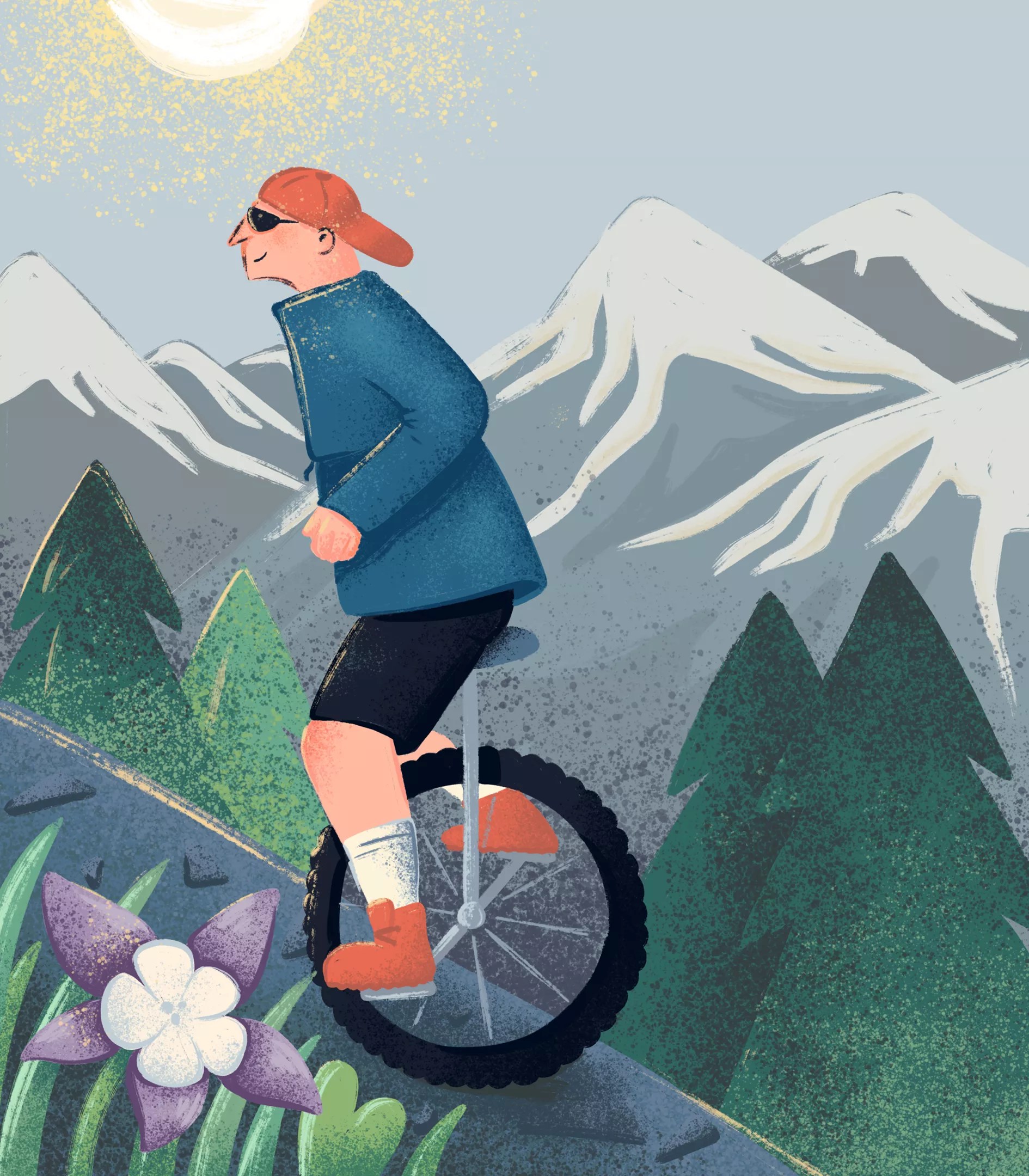
Monika Swiderski

Audio By Carbonatix
The mind does strange things at high altitude. However, that doesn’t explain the odd antics of some people at 14,000 feet. Of Mark Dierauer, who portaged Handies Peak with a heavy metal canoe; or Bill Kresge, who hula-hooped at the summit of every Fourteener; or those legendary Pikes Peak peanut pushers. But if not the dizzying elevation, what on earth explains these actions?
For some people, the answer is simple: camaraderie, fun, a desire to make your mark (while leaving no trace). Take it from these five adventurers who have done the seemingly impossible on Colorado’s Fourteeners.
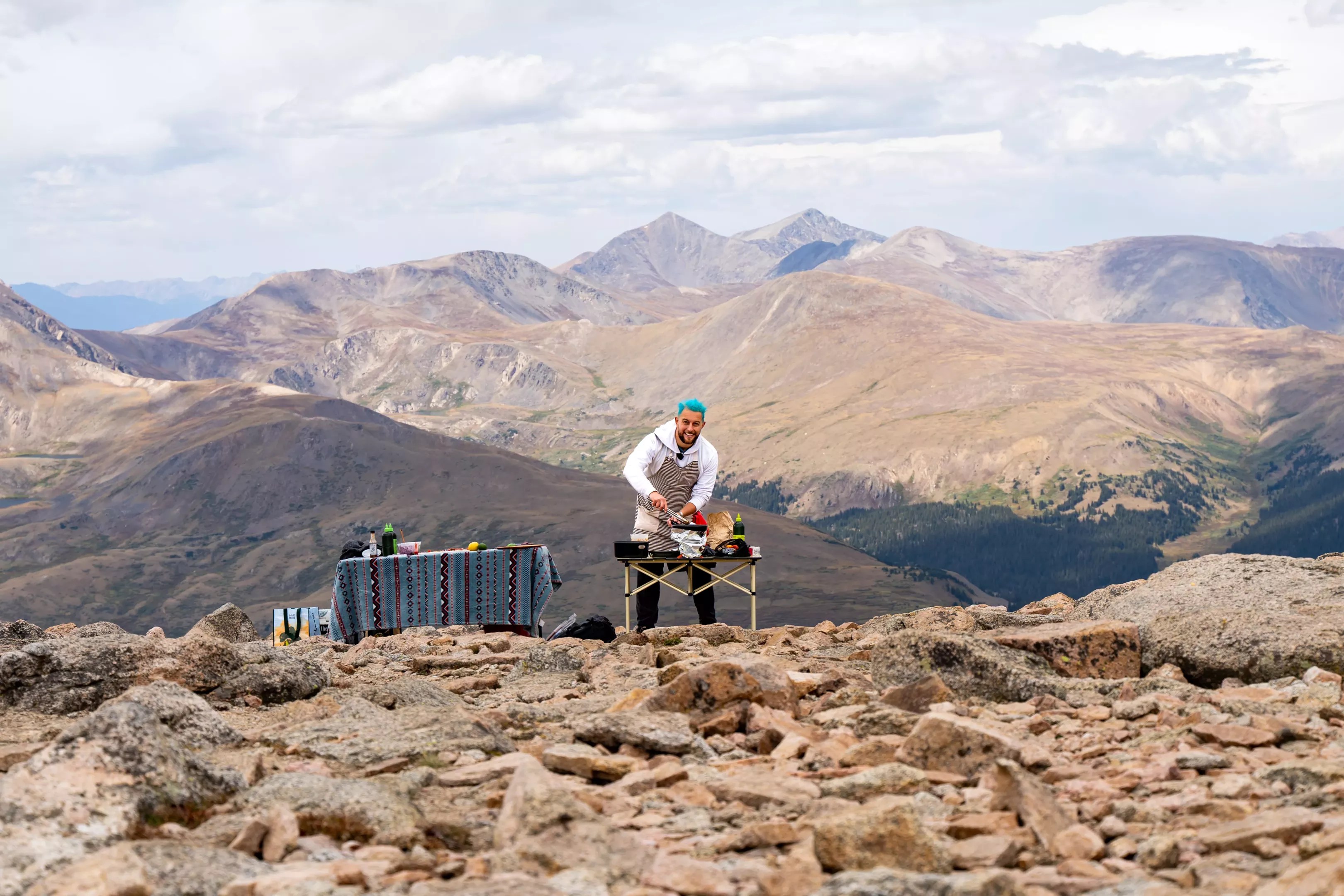
Connór Lock surprised hikers on Mount Bierstadt with a gourmet meal.
Mike Heath Photography
Connór Lock’s cooked up an epic challenge
Denver, make your New Year’s Resolution Count!
We’re $17,500 away from our End-of-Year campaign goal, with just a five days left! We’re ready to deliver — but we need the resources to do it right. If Westword matters to you, please contribute today to help us expand our current events coverage when it’s needed most.
Since his early twenties, Connór Lock has spent each of his birthdays in a far-flung destination. He funds his global expeditions through his design agency, although his friends often tell him that his real knack is for cooking.
While Lock has no interest in making that career pivot, the frequent comments got him thinking: What if he cooked on the side and incorporated that skill into his worldwide travels? Inspired, he started offering in-home cooking classes through his company, Staahj. A friend who’s a film producer thought he could take things further.
“He was like, ‘Dude, I think you have a cool concept here. This is different,'” recalls Lock. “So I decided to set forth on this adventure to film ten episodes all around the world.” Season one of The Cook’s Venture culminates on Mount Bierstadt, where Lock prepared an impressive meal this past September.
To prepare for this movable feast, Lock and his father built a wooden sled fitted with a chest harness. Prior to the big ascent, Lock loaded it with more than 100 pounds of gear: two collapsible tables, a camp stove, a box of dry goods and a box of utensils, a full Yeti cooler and more, including tools to fix the sled. Then he headed off.
With the sled, he skated along icy wooden bridges before sunrise and made it through a frigid creek crossing. But the sled broke several times along the rocky trail, and he realized it would not make the class two scramble to the summit…and a snowstorm was rolling in. So Lock got cooking.
He set up his kitchen at the base of the last pitch and began firing up Argentinian-style braised beef, which he served on garlic-charred sourdough bread. The toast was topped with fresh tomatoes, red onions and herbs, plus a chimichurri sauce and a spicy aioli.
Then Lock and his team, which included videographer Josh Berendes and photographer Mike Heath, packed it all out. “I couldn’t have done it without my amazing team and friends,” he says. “They’re a big part of this success.”
In all, the seven-mile journey took over eleven hours. It was extremely exhausting, but also “therapeutic,” Lock says. “I’ve been going through a lot of personal stuff. It’s been a really, really tough year, and I guess the symbolism of that sled was me carrying the weight on my shoulders.”
Cooking up and completing the challenge was an opportunity to reset and share something meaningful with his community. He hopes to launch The Cook’s Venture on YouTube when funding allows; in the meantime, he’ll be posting teasers on his Instagram account, @heystaahj.
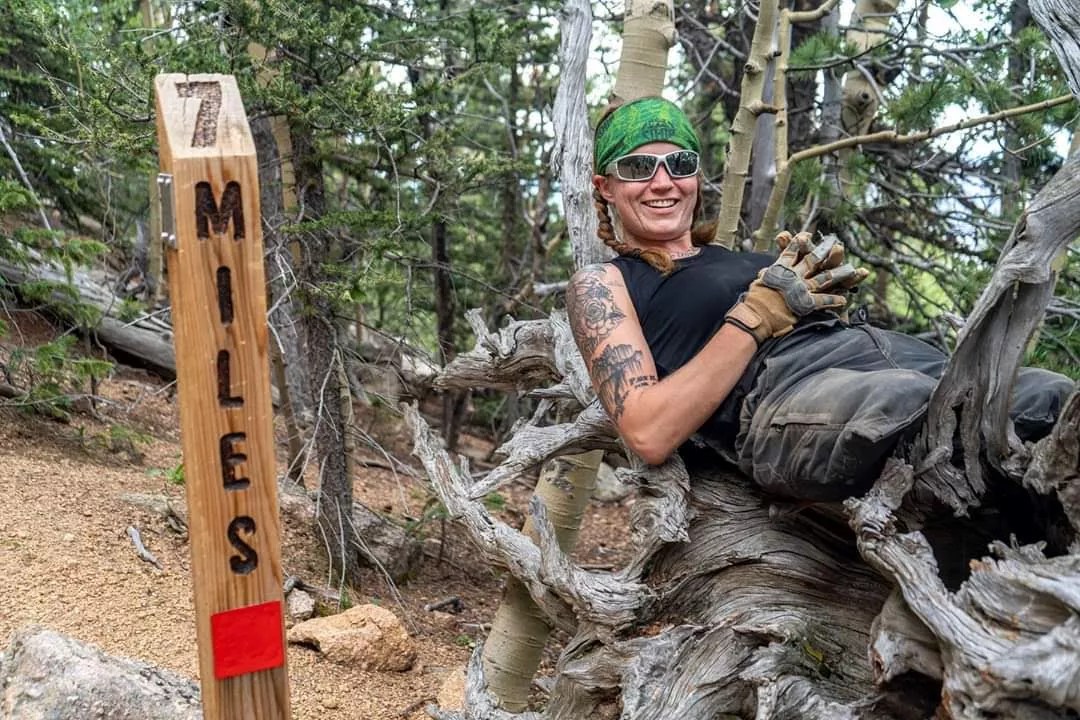
Mandy Horvath, a bilateral above-knee amputee, has set mountaineering records.
Mandy Horvath
Amputee Mandy Horvath reached record heights
When she was 21 years old, Mandy Horvath was struck by a train, and within an instant, her life was forever changed. She woke up from a medically induced coma as a bilateral above-knee amputee.
During her initial recovery, she lived with her parents in her hometown of Kansas City. She was struggling with alcohol use disorder, was on 22 different medications and gained a significant amount of weight. “I was really just wasting away,” recalls Horvath. “My dad, he woke up in a bad mood that morning. He stepped out of his bedroom and he looked at me, and he said some words that I will never forget: ‘Mandy, you’re a fat piece of shit that’s never going to amount to anything.'”
While Horvath took that very personally, it also was a catalyst for change. She and her father have since talked about that moment, and he admitted that he was scared when he made the comment. “He saw the bubbly little girl that he loved and raised turn into somebody that he didn’t recognize,” explains Horvath. “And he knew that he had to say something to get me up off the couch and to do something with my life.”
Two weeks later, Horvath was bound for Colorado and school at the ​​University of Colorado Colorado Springs. She became obsessed with the Manitou Incline, an iconic staircase that climbs more than 2,000 vertical feet in less than a mile and connects with the Barr Trail, which leads to the top of Pikes Peak.
“I begged people to take me up the Incline and the general consensus was, ‘No, you’re going to kill yourself. You’re going to hurt yourself. You’re going to be a liability for the search and rescue resources in the area, so on and so forth,'” recalls Horvath.
She was going through a dark time, dealing with suicidal thoughts and discouraged by those dismissals of her abilities. But mountaineer Daniel Pond and a colleague heard her pleas and agreed to support her mission of climbing the Incline. In 2018, Horvath became the first female double-amputee to complete the ascent without the use of prosthetic equipment.
Using just her arms and hands, Horvath climbed all the way to the top of Pikes Peak less than two months later. Pond again supported her expedition, which raised funds for veteran non-profit organizations Operation Ward 57 and the Battle Buddy Foundation. She did a second climb up Pikes Peak in 2019 in honor of another veteran nonprofit, Cars 4 Heroes; former Army sergeant Travis Strong, a fellow bilateral amputee, was right beside her.
Since then, Horvath has crawled up several other mountains and monuments, including Mount Kilimanjaro, for charities supporting veterans and conservation work. The story of her incredible journey up one of the world’s Eight Summits will be told in an upcoming documentary, Lioness. Horvath also completed Handies Peak, a Fourteener in Colorado’s San Juan Mountains, in 2023; she hopes to summit other Fourteeners in the future.
“I found a lot of purpose and meaning in my life through the mountains,” she says. “And I proved my dad wrong.”
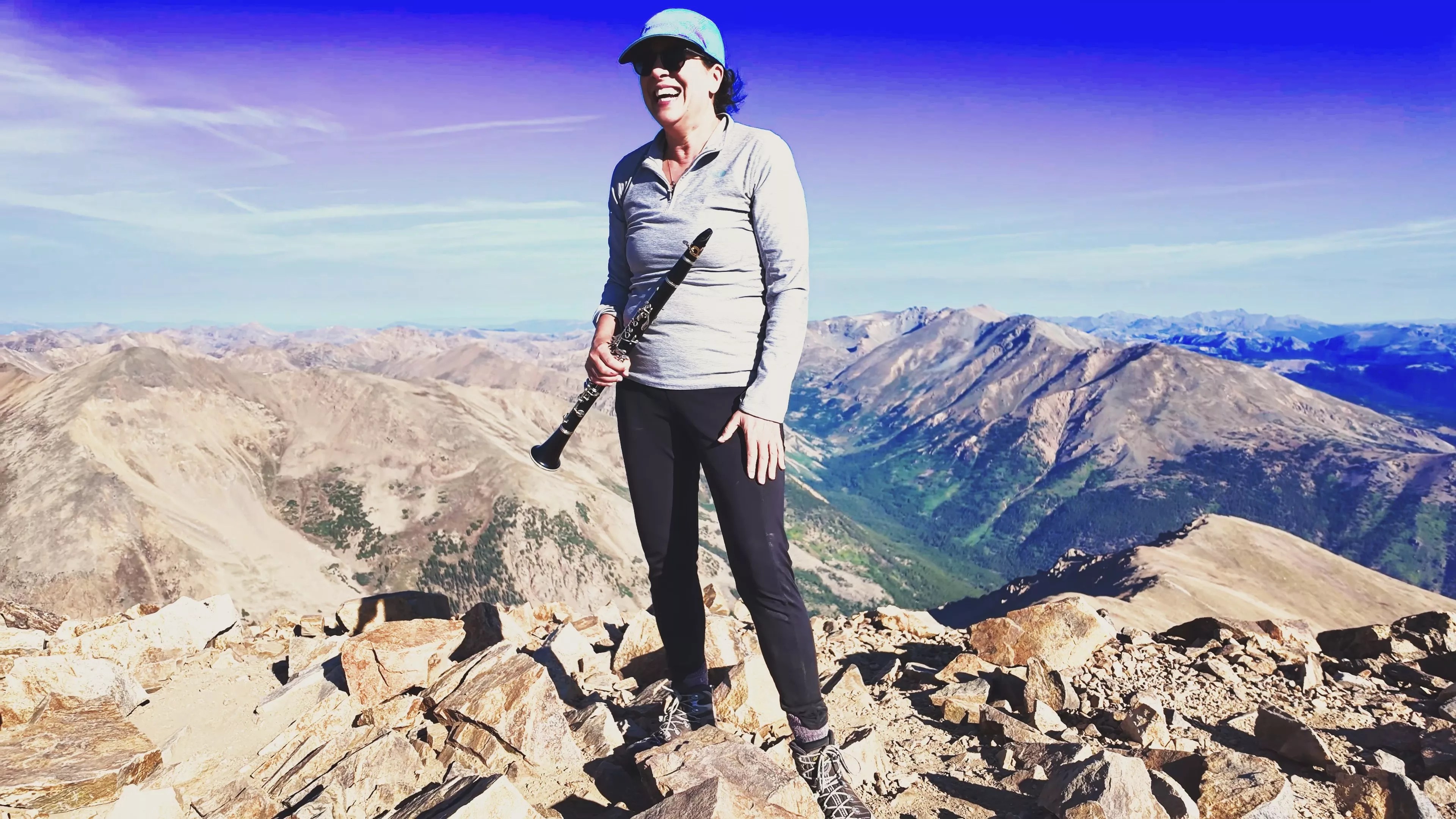
Stephanie Zelnick performed a classical clarinet concert on Mount Elbert.
Stephanie Zelnick
Stephanie Zelnick hit the high notes
In the early days of her career, Stephanie Zelnick worked as a mountain guide as well as an adjunct professor at the University of Wyoming. She also held principal clarinet positions with the Boulder Philharmonic Orchestra and Central City Opera, maintaining those roles even after she accepted a position at the University of Kansas School of Music.
“All of a sudden, I started commuting from 800 feet [in Kansas] up to Central City Opera, which is 8,500 feet,” she says. Zelnick had to sound as good as her altitude-adjusted peers, a challenge she faced with hardly any guidance.
“People in the mountaineering community write about how to acclimatize, and I started thinking, ‘Why is there no research when it comes to my community of musicians?’ There was very little literature on exactly what we should do to play at higher elevations successfully,” she explains.
Despite their use of smaller muscles, Zelnick ardently believes that musicians are athletes and that their performance can be optimized. To determine how, she’s interviewed woodwind players, traditional athletes, pulmonologists and other experts as part of a research project that has grown into a comprehensive look at musician health and well-being.
Though yet to be published as a book, research related to Zelnick’s study has already made headlines. In the name of science, she and a colleague, Lauren Jacobson, performed a clarinet duo at the Mount Bierstadt summit in 2022. This past September, Zelnick played the highest-recorded classical music concert in the Rocky Mountains from the top of Mount Elbert.
As a triathlete, ultramarathoner and mountaineer with thirty years of experience, Zelnick was ahead of her group that day. She made it up the east ridge and to the summit, where she performed a set for two hikers who happened to be there; one later posted the concert on Reddit.
Then Zelnick went back down to around 13,000 feet to join friend Melissa Davis-Capka and videographer Chris Clark. Around an hour later, they made it to the peak together. Zelnick set up her music stand, weighing it down with a backpack, and paper-clipped her sheet music into place.
“At that point, there were about ten or fifteen people up there,” recalls Zelnick. “It was nice having a bigger audience and the camaraderie was amazing.” She played four songs, including a piece titled “Pika” by composer Anne Guzzo, and posted her performance at 14,439 feet on YouTube.
Her next summit concert has yet to be scheduled. Right now, Zelnick is focused on completing her book, which she hopes will support the health and longevity of her community of musicians.

Chris Meehan has worn Chacos on many Fourteen climbs, including a few class five routes.
Meehan has hiked between fifty and sixty 14ers in Chacos, including a few class five routes.
Chris Meehan put his best foot forward…in Chacos
Most hikers who want to climb start out on popular Fourteeners like Mount Bierstadt, Mount Sherman or maybe Quandary Peak. But Chris Meehan is not like most people. After a night of college partying, he summited Longs Peak for the first time in jeans, a sweatshirt and a pair of K-Swiss shoes. “All things I recommend you never do,” he says now.
By 2010, Meehan had upgraded from sneakers to hiking boots, which he wore while trekking the Colorado Trail. But they were old and by day four or five, some really bad blisters were forming and he figured his camp shoes, a pair of Chacos, couldn’t be any less comfortable. Over time, this peculiar footwear choice became a preference – one that hasn’t hindered but helped him ascend more than fifty Fourteeners.
Meehan is partial to Chacos for a couple of reasons, he says. For one, stream crossings are no big deal as the shoes dry within minutes. Second, it’s easier to shake out pebbles than it is with lace-up boots. These situations occur often on Meehan’s adventures, especially on difficult traverses with rubble and rotten rocks.
Of the many peaks he’s completed in Chacos, the Maroon Bells Traverse and Crestones Traverse were the most challenging; on those expeditions, he admits that he carried a pair of back-up shoes. But he didn’t find them necessary on the class five climbs. Nor did he need a rope.
But then, when it comes to Fourteeners, Meehan is an expert among experts. He’s summited all 58 peaks, some several times, and authored the FalconGuides book titled Climbing Colorado’s Fourteeners: From the Easiest Hikes to the Most Challenging Climbs. In many instances, he notes that novices should not attempt to follow in his footsteps. But some routes aren’t nearly as nerve-wracking.
“You should always start with the easy ones,” he advises. “Elbert would be great to do in Chacos. It’s a pretty straightforward mountain, even though it’s the tallest. Handies was really fun to do in Chacos. It was an easy one and just a beautiful hike. I started from Grizzly Gulch, went over to American Basin on the backside and then thumbed it right back. It was an amazing day.”
The standard route up Quandary Peak is also a great beginner Fourteener; if you want to challenge yourself, he suggests checking out the west ridge. “There’s some mountains I’d love to go back and do it in a different way,” Meehan adds, citing the southwest ridge of Mount Sneffels – but that will have to wait a few more weeks.
“I haven’t hiked Fourteeners in Chacos in the wintertime because that would be ludicrous,” he jokes, although he has walked across summer snowfields with microspikes on his sandals. But for now, Meehan is content to work on a second edition of his guidebook that will include updated peak names and heights, as well as trail changes and additional routes.
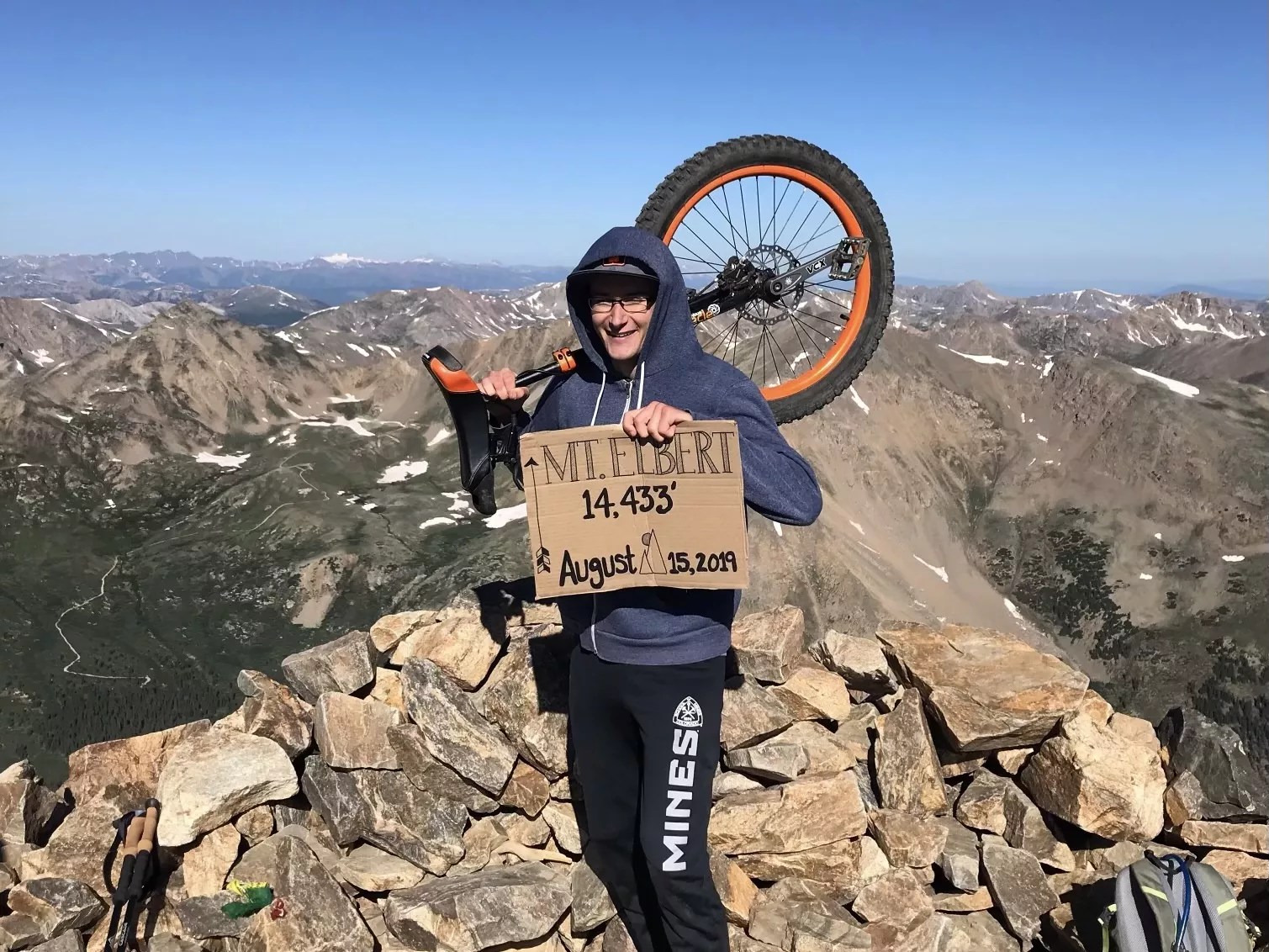
Caleb Kotter unicycled the entire Mount Elbert trail, including the ascent.
Caleb Kotter
Caleb Kotter celebrated wheel life
On Caleb Kotter’s sixteenth birthday, his father gave him his first unicycle. Kotter quickly mastered the sidewalks and roads surrounding his family’s home in Lakewood. Looking for a greater challenge, he wondered if unicycling on trails would be possible and answered that question by trying it out on Green Mountain, a prominent point along the Denver foothills.
After that, while studying at the Colorado School of Mines, he began unicycling down taller and scarier peaks. Word of his wild adventures spread around campus and Kotter became known as “the unicycle man.”
He’s now unicycled down eleven Colorado Fourteeners including Grays and Torreys, Quandary Peak and the DeCaLiBron Loop summits. Kotter even unicycled up Mount Elbert to the top before coming down the ridgeline.
Since unicycles lack gears, pedaling uphill isn’t always possible. “I might go up the foothills where it’s not super steep and more like a traverse,” he says. “But it’s hard to ride up scree and stuff like that.”
Descents can be tough, too. “Often, you have to squeeze between boulders coming off of a jump and that’s a little hard,” he jokes. “So I might pass that obstacle on foot or try to hop around it.”
A daredevil within reason, he does leave his unicycle at home for some alpine adventures – for example, a winter ascent up Mount Sherman and a class three scramble to the top of Longs. But he hopes to bag even more Fourteeners on his unicycle – he has five for different trail conditions – and has his eyes set on San Luis Peak, as well as Handies.
“The mental engagement and the physical exertion is a really fun combo,” he says.
The amazed looks he gets from other hikers is just a bonus.